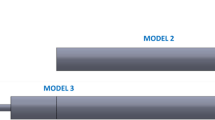Abstract
The objective of this research effort was to investigate the quasi-steady flow field produced by explosives in confined facilities. In this effort we modeled tests in which a high explosive (HE) cylindrical charge was hung in the center of a room and detonated. The HEs used for the tests were C-4 and AFX 757. While C-4 is just slightly under-oxidized and is typically modeled as an ideal explosive, AFX 757 includes a significant percentage of aluminum particles, so long-time afterburning and energy release must be considered. The Lawrence Livermore National Laboratory (LLNL)-produced thermo-chemical equilibrium algorithm, “Cheetah”, was used to estimate the remaining burnable detonation products. From these remaining species, the afterburning energy was computed and added to the flow field. Computations of the detonation and afterburn of two HEs in the confined multi-room facility were performed. The results demonstrate excellent agreement with available experimental data in terms of blast wave time of arrival, peak shock amplitude, reverberation, and total impulse (and hence, total energy release, via either the detonation or afterburn processes.
Similar content being viewed by others
References
Souers, P.C., Wu, B., Haselman, L.C., Jr.: Detonation Equation of State at LLNL, 1995. In: Energetic Materials Center Lawrence Livermore National Laboratory, 1 February (1996)
Cooper, P.W., Kurowski, S.R.: Introduction to the Technology of Explosives. Wiley-VCH (1996)
Schwer, D., Kailasanath, K.: Blast Mitigation by Water Mist (1) Simulation of Confined Blast Waves. NRL/MR/6410-02-8636
Kuhl, A.L., Forbes, J., Chandler, J., Oppenheim, A.K., Spektor, R., Ferguson, R.E.: Confined combustion of TNT explosion products in air. UCRL-JC-131748
Baum, J.D., Löhner, R.: Numerical simulation of shock interaction with a modern main battle field tank. AIAA-91-1666 (1991)
Baum, J.D., Luo, H., Löhner, R.: Numerical Simulation of a Blast Inside a Boeing 747. AIAA-93-3091 (1993)
Ramamurti, R., Löhner, R.: Simulation of flow past complex geometries using a parallel implicit incompressible flow solver. In: Proc.11th AIAA CFD Conf., pp. 1049, 1050, Orlando, FL, July 1993
Baum, J.D., Luo H., Löhner, R.: A new ALE adaptive unstructured methodology for the simulation of moving bodies. AIAA-94-0414 (1994)
Baum, J.D., Luo H., Löhner, R.: Numerical simulation of blast in the world trade center. AIAA-95-0085 (1995)
Baum, J.D., Luo, H., Löhner, R., Yang, C., Pelessone, D., Charman, C.: A coupled fluid/structure modeling of shock interaction with a truck. AIAA-96-0795 (1996)
Baum, J.D., Löhner, R., Marquette T.J., Luo, H.: Numerical simulation of aircraft canopy trajectory. AIAA-97-1885 (1997)
Baum, J.D., Luo, H., Mestreau, E., Löhner, R., Pelessone, D., Charman, C.: A coupled CFD/CSD methodology for modeling weapon detonation and fragmentation. AIAA-99-0794 (1999)
Ramamurti, R., Sandberg, W., Löhner, R.: Simulation of flow about flapping airfoils using a finite element incompressible flow solver. AIAA-99-0652 (1999)
Löhner R.: Renumbering strategies for unstructured-grid solvers operating on shared-memory, cache-based parallel machines. Comput. Methods Appl. Mech. Eng. 163, 95–109 (1998)
Tuszynski J., Löhner R.: Parallelizing the construction of indirect access arrays for shared-memory machines. Commun. Appl. Numer. Methods Eng. 14, 773–781 (1998)
Sharov, D., Luo, H., Baum J.D., Löhner, R.: Immentation of unstructured grid GMRES+LU-SGS method on shared-memory, cache-based parallel computers. AIAA-00-0927 (2000)
Löhner R., Ramamurti R.: A load balancing algorithm for unstructured grids. Comput. Fluid Dyn. 5, 39–58 (1995)
Ramamurti R., Löhner R.: A parallel implicit incompressible flow solver using unstructured meshes. Comput. Fluids 5, 119–132 (1996)
Löhner R.: Applied CFD Techniques. Wiley, New York (2001)
Dobratz, B.M., Crawford, P.C.: Properties of chemical explosives and explosive simulants. In: LLNL Explosives Handbook
Fried, L.E., et al.: Cheetah 4.0 User’s manual. LLNL (2004)
Author information
Authors and Affiliations
Corresponding author
Additional information
Communicated by C. Needham
Rights and permissions
About this article
Cite this article
Togashi, F., Baum, J.D., Mestreau, E. et al. Numerical simulation of long-duration blast wave evolution in confined facilities. Shock Waves 20, 409–424 (2010). https://doi.org/10.1007/s00193-010-0278-7
Received:
Revised:
Accepted:
Published:
Issue Date:
DOI: https://doi.org/10.1007/s00193-010-0278-7




